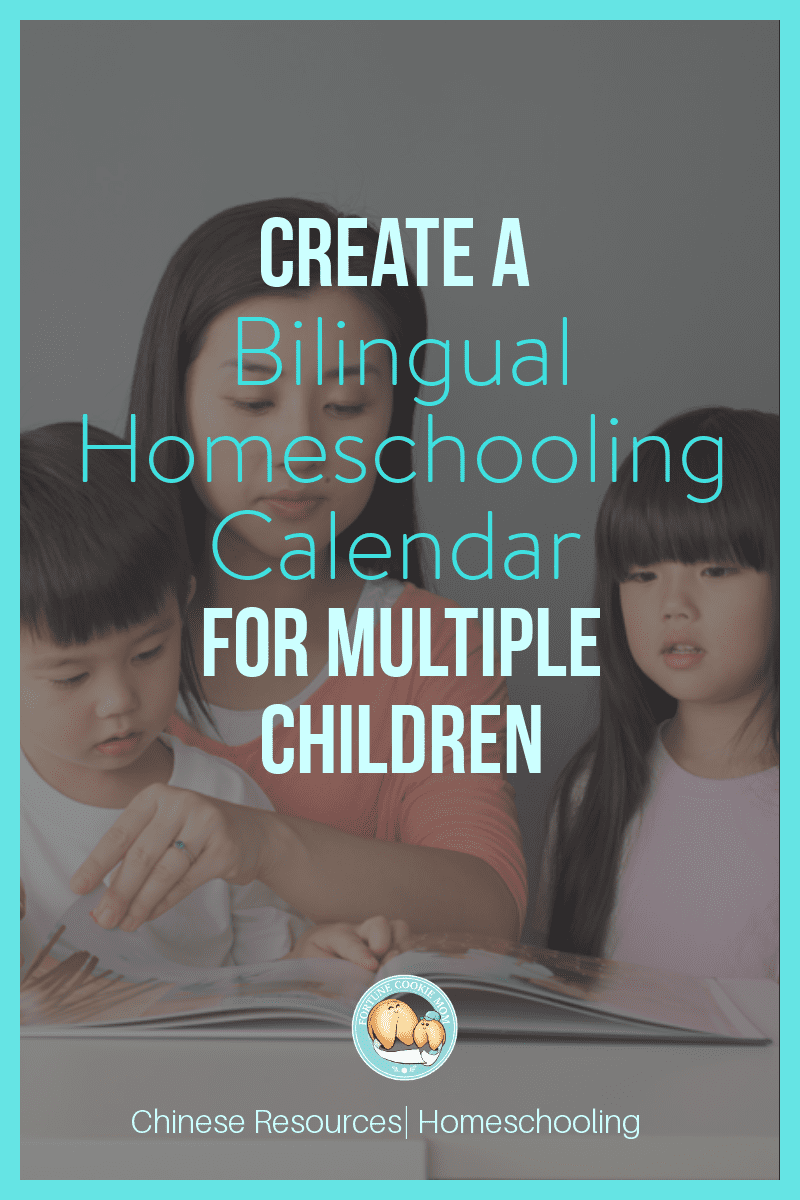Creating a monthly calendar for your bilingual homeschooling children can help you organize all your homeschooling days each month and last for a whole year.
I imagine my homeschooling calendar to be like a personal assistant. (I wish to have a real one someday.)
I don’t have to remember everything I need to teach or do for each of my children on a daily bases.
I always have a general idea of what my kids need to learn for both Chinese and English, so I don’t have to remember them all the time because my homeschooling calendar records everything for me.
Today, I am going to show you how I create a monthly bilingual homeschooling calendar for one or multiple children throughout the year.
For better results, I have made a FREE Workbook for you to download and follow along. This workbook will make the whole process much easier to do.
OK! Are you ready?
This is the 2nd STEP the series on How to Write a Year-Long Bilingual Homeschooling Plan.
Click HERE to learn all the steps of the whole planning process.
The post contains affiliate links, which means I may receive a small commission, at no cost to you. If you make a purchase through a link. See the Disclosure for more details.
Table of Contents
* Please scroll down to download a Freebie.
Steps 1: Get a Blank Calendar for Planning
When I first started planning to homeschool, I simply went online and printed out a yearly calendar from Print a Calendar. Even though it was just a plain calendar, it was enough to get me started.
However, when I started to plan for subjects and create a schedule for my kids, I found that just a plain calendar really wasn’t enough. I realized I needed to include both the US and Hong Kong public holidays.
I decided to make my own monthly calendar with both U.S. and Hong Kong holidays, and as a bonus, it has a beautiful Chinese design on it too!
Steps 2: Things to Consider when you are planning
Special Dates
Once you have your 12-month calendar, you can start planning your school days, but before you do that, you should mark the days you won’t have school.
For me, I start by writing down important dates for my family, such as:
- Birthdays
- Vacations
- Holidays breaks
- Events (any performances, fairs, etc.)
- When school will start
- When school will end
- Field trips
How Many Days of School will Fit You?
One of the benefits of homeschooling is that you can tailor it to your family’s unique needs. For example, you might ask yourself: How many days should I homeschool my kids?
But first, if you are in the U.S., make sure to check the Laws Governing Homeschooling, or Homeschool Laws in Your State, so you know the requirement for your State.
Some people prefer four or five-day school weeks. Some do a year-round school schedule with regular breaks. It is really up to you depending on your family situation.
Different Options of Yearly Planning
The Well-Trained Mind: A Guide to Classical Education at Home (By Susan Wise Bauer & Jessie Wise) shows us the following three options regarding yearly planning.
All three options have their own pros and cons, but they are easy to adjust to the needs of our families.
Which option do you like most?
OPTION 1
- School: September, October, November
- Break: December
- School: January, February, March
- Break: April
- School: May, June, July
- Break: August
OPTION 2
Year-around Homeschooling: Three weeks of school and one week for a break.
OPTION 3
It’s easy to adjust breaks and school around the U.S. holidays and when everyone is feeling tired of school. If you are not living in the U.S., you can also adjust your country’s holidays for your homeschool plan as well.
- School: September through mid-October
- Break: Week off
- School: Later October until Thanksgiving
- Break: Week off
- School Early December
- Break: Three weeks off for Christmas and New Year’s
- School: Mid-January until late February or early March
- Break: Two weeks
- School: March and April
- Break: Two weeks off
- School Late April, May, on through summer
- Break: Anytime during the summer
I Prefer Year-round homeschooling
There is no reason why I should home-school every day for nine months and take the summer off. It’s too stressful for me and my kids. I also don’t really enjoy the constant chaos and boredom during the summer. So we made every day a day to learn.
I chose option #2 and have 5-day school week because my kids and I both enjoy having a meaningful, educational activity planned for every morning.
(I will definitely try the other options if they fit my family’s needs and circumstances.)
The first three days of the week are usually a little heavier than the rest of the days because I teach with new resources and activities on these days.
For the rest of the week, I usually review the things my kids enjoyed the most, or we simply spend time playing together.
In reality, I only really prepare for 2-3 days a week, and the rest we just enjoy having fun.
*Since I have included both the U.S. and Hong Kong holidays, you will need to decide which ones are most important for your family so you don’t have too many holidays during your school year. Or you can try to incorporate learning experiences and activities about certain holidays and those days as school time.
Step 3: Plan for a General Theme Weekly/Monthly
This is my favorite part of planning! I love picking my monthly themes.
Since I decided to teach the same theme in both Chinese and English, I either plan to have a new theme every other week, or once a month.
Then I start picking themes. I write my ideas in pencil on the edge of the calendar. This allows me to make changes easily if I need to.
Tip: It is easiest if you fill in the seasonal themes first, e.g.: Back to School, Halloween, Thanksgiving, Christmas, New Year, Chinese New Year, Easter, Dragon Boat Festival, etc. After you fill those in, you fill in the remaining themes with the topics you and your child are most interested in, e.g: farm animals, princess, space, train, family, etc.
Pre-K Theme Ideas & Theme Packs
- Theme: Pre-K/Kindergarten Packs 主題(Fortune Cookie Mom)
- Themes for Early Childhood (Fantastic Fun and Learning)
- Pre-K Themes (PreKinders)
- 200+ of the Best Preschool Themes and Lesson Plans(Nature Beach Living)
Why don’t we start planning for subjects?
I usually don’t use the calendar to write in all the specific activities because the calendar doesn’t have enough space for me to write EVERYTHING.
However, if I have inspiration about what activities will work on a certain day, I make a simple note about it in pencil on the calendar, so when I am ready to start planning things in more detail, I will see that reminder.
Personally, I don’t start including details (subjects, activities, time, etc) until the next step. So stay tuned and you can read about in a later post (Step 4: Create a Routine with Appropriate Activities).
Now that you have an idea of what themes you are going to learn with your child during the year, your planning is halfway done.
Step 4: Create a list of books you will need
The next step is finding books to match your themes.
It doesn’t matter if you are using the literature-based method, , or any other approach – books are necessary to teach your child all sorts of skills.
By keeping a book list for the coming year, you can record what books you own, and what books do you need to purchase or borrow from the library or friends.
How Did I Create Book Lists for my Homeschooling?
You can collect your book lists by compiling on your own with a google sheet or document, make a board to collect books lists on Pinterest or search the internet.
I love using Pinterest to collect all kinds of inspiration and ideas from others. You can get all the answers with beautiful and clear images. I have included one of my own boards with images and images of book lists I would like to use.
Below are some great book lists I’ve found on the internet.
Do you have any other ways to collect your book lists? I would love to hear from you in the comment below.
- Homeschool Book Lists (Goodreads)
- Favorite Read-Aloud Books for Preschoolers (Simply Charlotte Mason)
- The Massive Guide to Homeschool Reading Lists (iHomeschool Network)
- Living Books List (AmyLynnAndrew)
- Living Literature Booklists (Our Journey Westward)
Finding Books for Both English and Chinese
Even more, people read books on their mobile devices, but there are so many more scientific benefits of reading printed books. Reading printed books has a vital role in human education.
However, it can be hard to find good books to match your themes. Especially when you need to find different languages, like Chinese books.
During my second year of homeschooling, I was teaching one week in English and one week in Chinese using the same theme.
To do this, I had to find at least an English book and a Chinese book on the same topic.
It was easy to find English books, but it was difficult to find age-appropriate Chinese books because many Chinese children’s books are too difficult with too many Chinese characters for my children.
This is when I started creating these FREE Chinese books to use with my kids when we were studying the theme in Chinese.
Please take a look at what I have created, and use them if they match the themes you are using.
However, if you are not able to find any books on the theme you have chosen, just try to find books on similar topics or characters. For example, if I can’t find any Easter book in Chinese, I will look for some Chinese books with rabbits or chicks in it because these are related to Easter.
Step 4: Where to Keep your Homeschooling Calendar
I like to keep my calendar in a plastic file folder where I can put each month into a separate plastic pocket. This way I can easily take the monthly sheet out of the pocket when I need to make corrections.
Also, there are usually enough pockets to hold all the other papers I used for planning (e.g. your goals, a monthly calendar, family schedule, supplies list, chores list, meal planning, etc.).
Other Tips:
- Keep it simple with little to no details
- Start 1-2 months before you want to start school, so you will have enough time to plan an entire year.
- Make corrections whenever you need to.
- Share your plan with your family, friends, and other homeschooling parents so you can get more suggestions and ideas.
Making a calendar is the first step towards making your vision and goals happen, but it doesn’t need to be perfect or complete.
Don’t be afraid of the changes!
Perhaps, you might need to make some changes after a couple of months into your plan. It’s totally ok!
Nobody is perfect and there will always be learning moments. We can only get better by being flexible and making changes as needed.
Keep up the good work, and remember you are doing an awesome job!
How do you usually keep your calendars and papers organized?
How long does it take you to plan for a whole year?
You Might be Interested:
- An Interview about My Homeschooling life in Hong Kong
- Homeschooling in Hong Kong: The Fortune Cookie Mom from Honey! I’m Homeschooling My Kids
- The Laws Governing Homeschooling from Though Co.
- Print Calendars from print-a-calendar
You Are Not Doing it Alone
Join my Facebook support group to meet and get connections with parents and educators with the same goals.
<<Don’t miss our next post on Decide on a Bilingual Teaching Approach >>

身为职业妈妈的我,常常牺牲睡眠来自作教材。版主全方位学习的新年教材真让我省下不少宝贵的时间找资料。四岁的女儿对中文学习有点抗拒。我们善用版主提供的迷你故事书和生字卡来增强她对语文的认识。版主的中文单词棋盘游戏更让女儿投入学习, 因为她想赢嘛!版主的教材可让小孩边玩边学, 太棒了。
This is the second 5-Day Challenge that we have done with Fortune Cookie Mom. Both have been very beneficial to our family. I am a homeschool mom of three little kids. We are not Chinese and do not speak any Chinese. With the help of Fortune Cookie Mom, we are slowly learning! The challenges have given me fun activities to do at home with the kids. Each one has reignited my kid's interest in learning. It has been a fun experience for everybody!







0 Comments
Trackbacks/Pingbacks